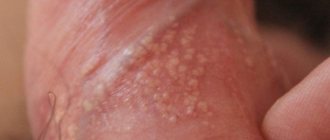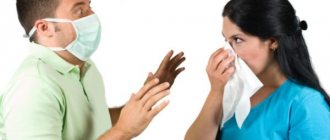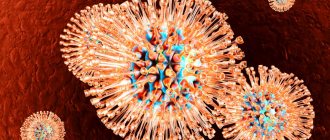HPV type 66 (HPV) is a type of papilloma virus that can cause dangerous degeneration into a malignant tumor. Decoding means strain number. In total, there are over 100 papillomavirus viruses; the incubation period of the disease is on average 6 months.
HPV type 66 belongs to the papillomavirus species Alpha papillomavirus 6 (until 2010, this species was called Human papillomavirus 53 (HPV53)).
In the classification according to the type of oncogenicity, it is included in the group with an average oncogenic status.
Infection with this strain does not guarantee one hundred percent development of malignant neoplasms, but under the influence of certain factors the risk of developing a dangerous disease increases.
The DNA of the virus is integrated into the nuclei of cells of the mucous membranes, with further proliferation of parasites and the death of healthy cells. If the pathological condition is not treated, oncogenic papillomavirus leads first to dysplasia, then to cervical cancer.
What it is
There are a large number of papillomavirus strains that have low, medium and high oncogenic risk. When the diagnosis is made: HPV type 66 in women - not every representative of the fair sex understands what it is and what it means for her.
HPV type 66 belongs to the papillomavirus species Alpha papillomavirus 6 (until 2010, this species was called Human papillomavirus 53 (HPV53)). In the classification according to the type of oncogenicity, it is included in the group with an average oncogenic status. Infection with this strain does not guarantee one hundred percent development of malignant neoplasms, but under the influence of certain factors the risk of developing a dangerous disease increases.
HPV type 66 is characterized by the appearance of condylomas on the mucous membranes. In most cases, it is not possible to diagnose this dangerous virus in a timely manner, since it does not cause noticeable manifestations on the skin. And when cervical cancer is detected, this strain of HPV is responsible in a third of cases.
Can it be transmitted sexually
Not all strains of papillomavirus can, and the sixty-sixth belongs to the group that is most often transmitted in this way. Moreover, it is not so important what type of sexual relationship you have with an infected person, but it can be:
- oral - in this case it is transmitted through saliva, and warts form in the mouth area;
- vaginal - in this case it is transmitted through infected genital areas, and formations appear on the genitals;
- anal - this type of pathology is especially often observed in males with non-traditional orientation, although it can also occur in men with traditional orientation.
Expectant mothers and women in general who have HPV should think about it, because sometimes there is a possibility that the child will become infected with the virus. This should happen when it passes through the birth canal.
However, such a risk is only a percentage, for this reason you should not worry too much. Your doctor will be able to give you the best recommendations. Sometimes, if there is a serious risk, a caesarean section is performed.
Causes of infection
Potential carriers of the human papillomavirus are 60% of the world's population. This virus is highly contagious and is easily transmitted from a sick person to a healthy person. In women, type 66 HPV can appear against the background of the following provoking factors:
- early onset of sexual activity;
- unprotected sexual intercourse with frequent changes of sexual partners;
- chronic inflammation in the female part;
- infectious diseases of the genitourinary system;
- frequent artificial terminations of pregnancy;
- weak human immunity;
- alcohol abuse and smoking;
- failure to comply with basic rules of personal hygiene;
- frequent exposure to stress;
- other STDs (sexually transmitted diseases);
- constant lack of sleep;
- long-term antibiotic therapy;
- hormone replacement therapy;
- avitaminosis.
Women aged 20 to 45 years who are sexually active are more at risk of infection.
Features of the 66 strain
This microorganism sits deep in the cells and waits there for its time. The hour comes when the patient’s body experiences a blow in the form of, for example, severe stress, poor nutrition, or a severe decrease in the level of immunity. As soon as one or another provoking factor appears, the virus begins to multiply rapidly. At the same time, it changes the DNA of the affected cells. This leads to their uncontrolled division and degeneration into malignant neoplasms.
Since the main route of infection with the disease is sexual, especially in combination with a low level of personal hygiene, the main risk group includes:
- people who are promiscuous;
- various lumpen people;
- alcoholics and drug addicts.
The latter’s bodies are especially sensitive to the virus—bad habits have long “killed” their immunity. Some doctors are also at risk, especially those who are constantly in contact with the secretions of carriers of the infection. Do not discount the contact route of infection, for example through a kiss. However, this happens very rarely.
There is a risk of congenital acquisition of HPV 66. The infection is transmitted from mother to baby at the time of birth.
Transmission routes
When infected, integrating into DNA, HPV type 66 promotes pathological changes in the composition and properties of cells. Under the influence of oncogenic type papillomavirus, the affected cell is transformed, which first causes cervical neoplasia, and subsequently cancer.
Infection with HPV type 66 occurs mainly through sexual contact with a carrier of the infection. Moreover, contact can be anything: vaginal, oral or anal. If barrier contraceptives are not used during sex, then the infection from the carrier’s body enters the partner’s body.
If sexual intercourse was unprotected, then the probability that a healthy partner will be infected reaches 60%. But condoms are not fully capable of protecting against infection, since the smallest viral elements pass through the pores of the latex product. In addition, the risk of infection increases significantly with a large number of sexual partners.
A domestic method of infection cannot be ruled out. This can happen when using someone else's personal belongings: towels, washcloths, underwear, cosmetics. Often infection occurs in public places: saunas, baths, water parks. A pregnant woman can infect her child during fetal development or during childbirth.
Precautions to take if you have a virus in your body
The papilloma virus cannot be completely removed. By following these precautions, you can reduce the likelihood of relapse to a minimum.
- Avoid casual sex. A condom does not provide any protection against the HPV virus.
- To refuse from bad habits.
- Individual products for personal hygiene.
- Moderate physical activity. Strengthening the immune system by any means: hardening, dousing with cold water, eliminating stressful situations, optimal sleep and rest.
- Maintaining hygiene rules.
- When performing cosmetic procedures or visiting tattoo parlors, monitor the sterility of equipment. When performing procedures, the master must wear disposable gloves.
- When visiting public places (swimming pool, sauna, bathhouse), use removable shoes.
HPV 66 is much easier to prevent than to treat. Early diagnosis at the first symptoms guarantees successful treatment. To prevent infection, it is necessary to follow the rules of personal hygiene and not use other people’s clothes or cosmetics.
The article has been reviewed by the site editors
How it manifests itself
HPV type 66 is usually discovered by accident, when a woman, noticing a papilloma on her skin, goes for a consultation with a doctor. As a rule, growths on the skin indicate infection with several types of papillomavirus. If everything happens this way, then dangerous HPV 66 is detected in time, before it has yet begun the process of malignancy with cervical cells.
But most often, a woman will not be able to independently assume that she has HPV type 66, since condylomas are located inside the female genital organs and are not visualized externally. At the same time, there are a number of signs that allow you to suspect you have HPV and visit a gynecologist in time:
- atypical vaginal discharge (sometimes mixed with blood);
- genital itching;
- pain during sexual intercourse;
- burning during urination;
- decreased libido.
It is characteristic of HPV type 66 that, compared to many other strains, it has the smallest number of visible manifestations. Very rarely, condylomas may appear on the labia minora, which the patient discovers on her own. And in most cases, this type of virus is not visualized in any way.
Factors of occurrence
Those suffering from papillomavirus genotype 66 do not always become victims of cervical dysplasia. Certain conditions contribute to this:
- the patient was pregnant and gave birth several times;
- for a long time was treated with products made on a hormonal basis;
- an intrauterine device has been used for a long time;
- the patient suffers from hypervitaminosis;
- has recently become infected with the human immunodeficiency virus;
- sexually transmitted diseases;
- frequent change of partners, promiscuous sexual intercourse;
- smoking cigarettes for a long time.
The risk of oncology appearing on the cervix is present in cases when sexual activity is just beginning (when the genital organs are not yet fully formed).
Diagnostics
Taking an anamnesis for HPV strain 66 can provide some general information about the progressive disease, but it is not able to absolutely accurately determine its nature and help with the choice of therapeutic tactics. If papillomavirus is suspected in women and dysplasia is present, the gynecologist conducts research:
- taking a smear from the cervical canal;
- taking a scraping from the cervix;
- blood analysis;
- targeted biopsy with further study of the biopsy material.
But the basis for diagnosing human papillomavirus is polymer chain reaction (PCR). It involves taking blood from a vein. And recently, a new method for diagnosing HPV has appeared - the Digene test. It allows you to find out how active the virus is in the body.
Types of HPV - human papillomavirus
Human papillomavirus (HPV) is the most common, predominantly sexually transmitted infection in men and women worldwide.
Human papillomavirus belongs to the papovirus family, subgroup A.
Today there are about 150 types of papillomavirus.
A special place among them is occupied by types that can lead to the development of malignant diseases.
Based on the risk of developing oncogenic diseases, these types can be divided into 3 groups:
- High risk - 16, 18, 45 and 56 (HPV types)
- Average risk - 30,31,33,35,39,51,52,58,66 (HPV types)
- Low risk - 6, 11, 42, 43, 44, 53, 54, 55 (HPV types)
High-risk HPV (HPV type 16, HPV type 18, HPV type 45, HPV type 56) can cause cancer of the cervix, vagina, vulva, penis, anus, and oropharyngeal area.
Low-risk HPV causes anogenital warts, as well as condylomas of the larynx and respiratory tract.
It is known that at the stage of initial manifestations, HPV-associated diseases may not be accompanied by characteristic symptoms and are not clinically significant, but chronic infection (persistence) can lead to severe lesions and cancer.
I would like to draw the attention of patients that even the presence of viruses with low oncogenic activity is a reason for treatment.
Human papillomavirus and its types can be classified according to tissue sensitivity, i.e. by preference to damage certain tissues.
For example, HPV types that are prone to infecting the skin are determined. In this case, the virus manifests itself in the form of plantar warts, flat warts, epidermodysplasia verruca, etc. These types of papillomavirus include HPV types: 1, 2, 3, 4,5,7,8, 9, 10, 12, 15, 19, 26, 27, 28, 29, 36, 37,38, 49, 57 .
Accordingly, there are types of HPV that are prone to primarily affecting the mucous membranes. In this case, the virus manifests itself as genital warts or non-condylomatous lesions. These types of papillomavirus include HPV types: 6, 11, 16, 18, 30, 31, 33, 34, 35, 39, 40, 42, 43, 44, 51, 52, 54, 55, 56, 57, 59 , 61, 64, 66, 67, 68, 70.
If any type of HPV is detected, you must consult a specialist and undergo a full course of treatment. You can find general recommendations in the corresponding section.
HPV is a nuclear DNA-containing virus that, during the infection process, can integrate (integration of the virus genome) into the cellular chromosomes of the infected organism.
An important role at the stage of HPV infection is played by viral proteins that are responsible for the transcription process, initiating viral replication and encapsidation of the viral genome. When infected cells of the basal layer of the epithelium divide, the virus genome is transferred to the daughter cell.
The effect of the virus on the cell (cytopathic effect) can be varied: lead to the complete destruction of the affected cell (cytolytic effect), long-term coexistence of the virus and the cell without the death of the latter (latent and persistent infection), as well as to its transformation.
Viruses do not form typical toxins, however, both virions and viral components that accumulate in affected tissues have a toxic effect. In addition, cell breakdown products also have a toxic effect.
Due to the severity of the disease outcomes, much attention has been attracted to HPV damage in the cervix, which can lead to the formation of precancerous processes and cervical cancer.
The role of HPV as a cause of the development of precancerous diseases and cervical cancer is confirmed by epidemiological data, the detection of viral DNA in affected cells (both in integrated and episomal form), and the expression of viral genes in tumor cells.
A number of researchers have noted that although most women with atypical squamous cells of undetermined significance (ASCUS) or low-grade squamous intraepithelial lesion (LSIL) may not have clinically significant manifestations of the disease, subsequently, a significant proportion of them develop histologically confirmed severe lesions of the cervix (cervical intraepithelial neoplasia - CIN II–III). Scientists have estimated that 1/3 of CIN II–III was found in women whose previous screening result was consistent with ASCUS.
Reviews about Panavir, questions, doctor's comments
Anna Kireeva asks: 2020-04-28 10:09:30
Good afternoon! Does it make sense to continue treatment for HPV 16 and 18? Today the doctor said that after isoprinosine, treatment is no longer prescribed, but the condition is simply monitored periodically. I wouldn’t want to sit on a knife like this all my life. Maybe change gynecologist?
Korobkova Elena Vladimirovna Obstetrician-gynecologist answers: Good afternoon. You need to take a quantitative HPV test. If signs of infection persist, we can recommend IV Panavir - systemic action and vaginal suppositories - local. After 3 months, take a quantitative HPV test. If in your city they test for E6 and E7 oncoproteins, then it is better to do so; this will further determine the tactics of treatment/observation. After treatment is completed, you can use Panavir Intim spray to prevent the development of infection. Thank you.
Christina asks:2020-03-03 02:19:10
Hello, I was diagnosed with cervical erosion, then HPV 16 (5.2*10^5) 45 (1.3*10^5) and 51 (8.2*10^5), also ovarian cysts, how serious is it?
Korobkova Elena Vladimirovna Obstetrician-gynecologist answers: Good afternoon. The cause of the ovarian castes needs to be clarified, as for HPV tests, types 16 and 51 are found in concentrations that are clinically significant equivalent. This indicates high activity of the virus and a high risk of developing cancer in the presence of unfavorable factors. Currently, there are many drugs for the treatment of this disease, among which the drug Panavir has proven itself well. For systemic treatment, forms in the form of an injection solution or rectal suppositories are used; for local treatment, vaginal and gel suppositories are used. Thank you.
Natalya asks:2019-06-21 21:50:35
Hello, today my daughter was diagnosed with HPV type 16 (5.5), cervical erosion, is this scary, she has not given birth, can it be cured and will she be able to give birth. Thank you.
Korobkova Elena Vladimirovna Obstetrician-gynecologist answers: Good afternoon! In young people, the virus may disappear, but given the presence of erosion, there is a high risk of developing the process. As far as I understood correctly, 5.5 is a quantitative value. In this case, clinically significant, treatment is necessary. You can cure it and give birth, too, with a “good” cervix, after treatment. As a medicinal therapy, the drug Panavir has proven itself well in complex treatment; there are forms for intravenous administration, rectal and vaginal suppositories (suppositories), and as a preventive measure - the Panavir Intim spray. The variety of forms ensures continuity in treatment and reliability of the result. For tactics and choice of treatment for altered cervical epithelium, it is necessary to perform colposcopy and a cytology test. Don’t delay the examination and treatment. Thank you.
asks:2019-01-24 06:31:02
Hello, my husband and I are preparing for IVF; he was found to have HPV type 18 DNA, how can we get him involved? What kind of drug were the urologists didn’t really say anything, they just said that if it’s not cured, it won’t cure him, but we need it urgently, tell me what to do?
Menshchikova Galina Vladimirovna Dermatovenerologist, dermato-oncologist. Candidate of Medical Sciences. Doctor of the first category. More than 15 years of experience answers: Good afternoon. Get tested for PCR from the urethra - quantitative. Are there clinical manifestations?
Tatyana asks: 2018-12-30 17:31:21
Hello, I was diagnosed with HPV 56, how terrible is this? What treatment will be effective? And how long will the treatment take? Are there condylomas on the labia? You have been prescribed treatment with isoprinosinol, how effective is it? Thank you
Menshchikova Galina Vladimirovna Dermatovenerologist, dermato-oncologist. Candidate of Medical Sciences. Doctor of the first category. More than 15 years of experience answers: Good afternoon. Condylomas should be removed. The destruction method should be chosen by the doctor after examination. In addition to the course of isoprinosine, I recommend undergoing intravenous treatment with Panavir solution according to the scheme: days 1, 3, 5, 8, 11.
Natalya 18 years old asks:2018-12-24 11:07:14
Positive HPV 18 type 10*1. Tell me is it dangerous?
Menshchikova Galina Vladimirovna Dermatovenerologist, dermato-oncologist. Candidate of Medical Sciences. Doctor of the first category. More than 15 years of experience answers: Good afternoon. No. This is not a clinically significant result.
Olga asks:2018-09-04 01:03:10
Hello! HPV type 16 detected. Please tell me what “1.6 x 10'4” means. It’s not too soon to see a doctor, so I’m losing my temper from the uncertainty. Is this very scary? Thank you.
Bagaeva Madina answers: This is the quantitative value (titer) of the virus. Type 16 is highly oncogenic, but the full diagnosis and treatment tactics depend on the condition of the cervix. Today, with timely treatment, all this can be successfully treated.
Anna asks:2018-07-25 11:36:19
Good afternoon, I received a result for HPV 16 type 3.4x10*4. Could you please explain how dangerous this indicator is?
Bagaeva Madina answers: type 16 belongs to the group of high oncogenic risk. This is one of the most dangerous types, and the severity of the situation depends not only on the titer, but also on the condition of the cervix and concomitant somatic history.
Valeria asks: 2018-07-14 01:38:29
Good day! To my horror, I was faced with a positive result for HPV types 39 and 68, a week has passed since unprotected sexual intercourse. Before this everything was negative. How long will the treatment process take and how critical is it?
Bagaeva Madina answers: Therapy can take from 14 days to 3 months, it is very individual. It makes sense to take repeated tests no earlier than 3 months after the end of therapy.
Irina asks:2018-07-02 13:07:07
Hello! In September 2020, HPV 16 was discovered. She underwent a course of treatment. At the beginning of 2020, during repeated analyzes (3 month interval) the indicator was 0 (not detected). During treatment, the partner caressed with his hands, without sexual contact. After treatment and a negative result, regular unprotected sexual contact with the same partner (permanent). Questions: 1. Could the partner become infected during hand lax? 2. If PCR shows a negative HPV 16, is it possible to donate DNA (blood) for HPV detection? How to understand whether the virus has been eliminated or is in dormant mode and can pop up when the immune system is weakened? Thanks in advance for your answer.
Bagaeva Madina answers: Good afternoon! Yes, it is possible to become infected through close physical contact. Yes, it is possible to detect HPV DNA in the blood using PCR.
Olga asks:2018-06-18 03:51:03
A diagnosis was made: Cervical dysplasia with a positive titer of 3.1. I am undergoing treatment according to the scheme. The question is, can this be cured?
Dmitry asks:2018-06-07 23:04:47
Please tell me. The child is one year old and has swollen tonsils and something is not clear about the demolition. We did a saliva test using a hemotest. But we can understand it Epstein-Barr virus 5.9x10*4
Bagaeva Madina answers: Good afternoon! EBV was detected in a titer at which it is already possible to carry out antiviral therapy. Plus there are clinical manifestations. Taking into account the child’s age, only a pediatrician can select therapy.
Anastasia asks:2018-05-28 12:00:44
Good afternoon, here’s a question. I was diagnosed with HPV16 and prescribed treatment. It is possible that I am pregnant, the period is 1.5 weeks. The doctor said to start treatment after I know for sure whether I’m pregnant or not, that is, after menstruation. There are still 2-3 weeks before menstruation. What will happen if I start treatment without waiting for menstruation, how will it affect and what?
Bagaeva Madina answers: Hello! Depends on what medications you plan to take. For the first 5-7 days, the embryo is not yet embedded in the endometrium and lives, as it were, “independently” of the mother’s body. But this is only 5-7 days after the fertilization of the egg.
Irina asks:2018-03-22 17:29:39
Hello! I’m 37 years old. I was diagnosed with HPV 16. I was diagnosed with squamous cell cancer. I’m currently undergoing radiation therapy. Is it possible to cure HPV after radiation? Doctors are planning to remove the uterus, I haven’t given birth yet.
Bagaeva Madina answers: Of course, you can undergo antiviral therapy. But the need for surgery is determined not by the presence of the virus in the body, but by changes that have already occurred in the tissues of the target organs.
Maria asks:2018-03-21 13:30:30
Hello! They discovered HPV-16, cervical erosion. They told me to get treatment, it’s okay. I’m very scared. Please tell me an effective treatment method. I read what HPV is, but how is it treated. Thank you.
Bagaeva Madina answers: Have you had cytology done? In the presence of erosion and HPV, this is mandatory. Treatment is primarily antiviral systemic and local. Panavir solution in ampoules (No. 5 IV) and vaginal suppositories (No. 10, daily at night) are suitable for this.
Elena asks:2018-03-13 08:19:06
Hello, please tell me I have been diagnosed with HPV 36 and 44 due to HIV. Is treatment possible?
Bagaeva Madina answers: At the discretion of your attending physician and under the control of an immunogram.
Anna asks:2018-03-06 15:07:37
Hello! I was tested and the result was HPV 18 33 45 52 58 67 positive! What does this mean ?? Is it sexually transmitted? What to do ?
Bagaeva Madina answers: It is sexually transmitted. Among the types you listed, there are types that belong to the group of highly oncogenic ones. Therefore, a detailed examination is necessary (colposcopy and cytology if necessary).
Elena asks:2018-02-03 11:37:08
Last year (June 2017) bloody discharge appeared. We did a cervicoscopy (the uterus was removed in 2020 - multiple fibroids of the uterus). Histology analysis showed 2-3 dysplasia. After review at the oncology center, 1-2 tbsp. I passed all the tests for conization - HPV 16 and 18 were detected. We had a conization done at the oncology clinic. Treatment was prescribed: doxycycline for 8 days, metranidozole for 7 days, terzhinan for 10 days, then depantone for 10 days. After this treatment, isoprinosine 10 is administered every 10-3 courses. I’m waiting for histology after conization... It’s scary, I don’t know what will happen next. What can you advise and how can I continue to live with this? I'm already completely desperate...
Bagaeva Madina replies: Don’t take it to heart, everything is not as scary as it seems. I can advise you only after the results of histology and a repeat analysis for HPV determination.
Maria asks:2017-12-22 00:53:21
Hello, I have a slight uterine erosion. And they discovered HPV type 35 in her, how dangerous is it and what medications can be used to get rid of this virus? Thank you
Bagaeva Madina answers: Hello! Any type of HPV is oncogenic to one degree or another. The presence of erosion increases the chances of developing cancer pathology. It is necessary to do a colposcopy and do cytology (preferably liquid).
Ksenia asks: 2017-12-11 11:08:45
Good afternoon. I was diagnosed with HPV 6.11 a long time ago. I recently removed condylomas on the vaginal walls. I am on immunotherapy Groprinosin/Genferon. I insisted that the young man was tested for HPV and was diagnosed with 16 and 32. How high was the likelihood of infection with HPV 16 for me and is it possible for us to be completely cured?
Bagaeva Madina answers: Of course there was a possibility of infection. Even with a single sexual contact it is approximately 60%. In my opinion, at this point, your mutual antiviral therapy would be logical.
Treatment
It is not possible to completely recover from HPV type 66, as well as from any other strain of this virus. When a dangerous oncogenic strain is identified, its manifestations in the form of growths on the mucous membranes are first removed, and drug treatment is prescribed to increase the patient’s immune status so that the body can suppress the activity of the virus.
Surgical methods
Therapy for type 66 human papillomavirus begins with the removal of growths on the mucous membranes or cervix. When choosing a method for removing tumors, specialists take into account the location, size of the condyloma, as well as the woman’s general health:
- To remove small growths, electrocoagulation is mainly used. During the procedure, the roots of the condyloma are exposed to electric current. And to avoid bleeding, coagulation of blood vessels is immediately performed.
- Laser removal of tumors involves layer-by-layer burning of pathological tissues. However, when removing condyloma in the vagina, this method may not be available.
- Another popular method is radio wave excision. This method involves removing condylomas with a radio knife. During manipulation, there is no direct contact between the tissues and the device, and the blood vessels are immediately sealed, which eliminates bleeding after destruction.
If a woman turns to a gynecologist at an advanced stage of the pathological process, then complete removal of the reproductive organs may be required, followed by a course of chemotherapy.
Treatment methods for HPV type 66
Today, medicine is practically powerless in completely eliminating the papillomavirus. Existing means and methods can only suppress the development of infection and prevent malignancy of tumors. Treatment of human papillomavirus type 66 is only possible in a comprehensive manner using drugs from various groups and destruction of growths.
Medicines for HPV 66 strain
Immunomax - enhances immune defense against viral and bacterial infections.
The use of drugs of the antiviral and immunostimulating group can prevent the development of the virus and its activation up to the development of oncology. There are also groups of drugs that can destroy tumors. Let's look at them:
- Immunomodulators and immunostimulants . They are prescribed for the treatment of HPV type 66 after analyzing the patient’s immunogram. As a rule, this is part of complex therapy for a general weakening of the patient’s immunity. The main task of these medications is to activate defenses, enhance the production of immune cells, and stimulate the synthesis of antibodies. These drugs are available in tablet, injection, and ointment form. The following have proven themselves well for the treatment of human papillomavirus type 66: Allokin-Alpha, Immunomax, Isoprinosine, as well as analogues - Gepon, Galavit.
- Antiviral . The main goal of antiviral treatment is to reduce the load on the body and stop the spread of the pathogen. Drugs in this group can be prescribed as monotherapy or as part of complex therapy. You can use Viferon, Genferon, Altevir, as well as analogues - Panavir, Epigen Intim (read reviews of Epigen Intim spray for condylomas).
- Means of destruction of neoplasms . If HPV type 66 manifests itself in the form of papillomas or condylomas, then these neoplasms should be eliminated. To do this, you can use chemicals that have a destructive effect. To remove type 66 genital papillomas in women and men, salicylic-resorbing collodion, trichloroacetic acid, as well as analogues of Solcoderm for warts and nitric acid are used.
- Cytotoxic drugs . These drugs are inhibitors of cell division. These are medications for external use. They are used only on the external parts of the body, not on the internal genital organs. The most popular are Podophyllin and Podophyllotoxin. They include plant resins. Their analogue, 5-fluorouracil cream, has also proven itself well.









